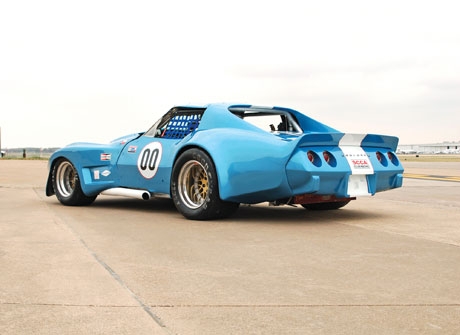After many years in retirement, Corvette Grand Sport racer Delmo Johnson was encouraged by some Texas friends to become involved in vintage racing. He acquired this, his last race car, around 1990 from his old friend John Mecom, an equally famous Texan.
The car began life in 1967 as a Sting Ray racer, and had a distinguished racing history, having been driven by the likes of Alan Sevadjian and finishing first at the 1979 SCCA Runoffs before being disqualified on a technicality. It later crashed at Road America in 1982 with Sevadjian at the wheel when the throttle stuck. Although it flipped many times, Alan emerged unscathed.
The car was rebuilt and prepared to 1974 IMSA and SCCA GT1 specifications without regard to cost. It has far too many competition upgrades to list, including a fuel cell, safety cage, adjustable suspension, fire-suppression system, and IMSA-legal wide-body configuration. The safety cage doubles as a chassis frame improvement that leaves the car many times stiffer than stock. Delmo says he wanted the car because it reminded him of the Grand Sports, and he knew no better car of its type existed.
The professionally built 366-ci Chevrolet cast-iron small-block engine is ready to race and has run less than one hour since completion. It is equipped with a forged steel crank, aluminum heads, cog belt-driven dry-sump lubrication system, and 750-cfm Holley carb. An all-synchromesh close-ratio Borg Warner Super T-10 aluminum-case transmission, limited-slip rear axle, aluminum radiator, oil, transmission, and power-steering coolers, competition gauges, and an onboard Halon fire system are also included. All accessories are state of the art, and the car is carefully prepared and is legal for three major vintage racing clubs. The legal weight is 2,850 pounds, equating to 4.22 lb/hp with the engine’s 675 horsepower.
The 1974 IMSA cars are the newest and among the fastest in vintage racing. This car will be supplied with signed testimony by Delmo Johnson and will be autographed by him if the purchaser desires.

